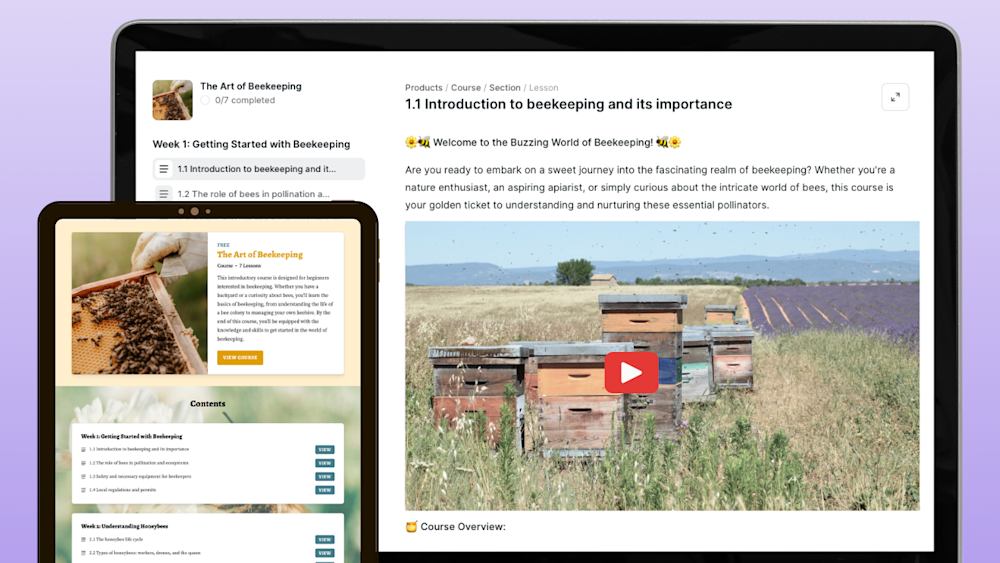Let’s face it -- not all online course launches are a smashing success.
Even if it isn’t a flat-out failed course launch, there still may be a time that you want to close up enrollment for good.
Maybe you want to pivot your business to serve a different target audience.
Or maybe your online course is outdated, and you want to offer your audience a fresh, better online course.
Whatever the reason may be, if you’re thinking about shutting down an online course, you’re in the right place.
Today, we show you how to do it gracefully -- including a plan with four key steps and email templates -- without losing face or your customers.
Let’s get to it.
4 steps to seamlessly shut down an online course
Step #1. Log all of your valuable learnings
First and foremost, it’s important to glean all the insights you can from your online course experience.
With every challenge in your business, there are lessons that teach you how to be a stronger, more resilient, and, ultimately, more successful entrepreneur.
Cofounder and CEO of Third Summit, Matt Cimaglia, explains how it’s vital to see failure as a business lesson, and not a dead end.
In Matt’s words:
“Seeing failure as a dead end is the most significant mistake you can make as an entrepreneur, or indeed in your life. It's fine to ditch an idea that isn't working, as long as you learn from it and integrate that knowledge into your next plan.”
So, to integrate lessons into your next plan, try to get crystal clear on post-mortem details like:
-
Why exactly are you shutting down your online course?
-
What went wrong?
-
What went right?
-
If you could do it all over again, what would you do differently?
A post-mortem analysis is especially useful if you’re planning to continue running your business after retiring your online course -- particularly if you’re serving the same niche audience.
Why? No matter what, after launching an online course to your audience, you learn more about your target audience throughout the experience.
This means you get to know about their needs and wants at a deeper level, which lets you cater to them more accurately moving forward.
Put another way, you can look at your retiring online course as an experiment. And the more failures you experience, the closer you are to your goal.
Take, for instance, big tech companies like Bing, Google, LinkedIn, and Office.
They’ve realized how vital learning experiments are for increasing their bottom line -- to the point of exponentially increasing the number of daily controlled experiments in recent years.
With an abundance of experiments constantly running in the background, they’re bound to hit on big winners that bring in the dough.
And here’s another perspective to consider: You can help other people with your story of so-called online course failure, in the same way that you can learn from others’ mistakes.
Research tells us that stories of failure lead to learning transfer, so you can help both yourself and your fellow entrepreneurs and solopreneurs, too.
Philanthropic gestures aside, though, the point here is to glean everything useful from your expiring online course experience to prep you for your future successes.
You can save some of your course content, too. Our next step shows you how.
Step #2. Figure out if and how to repurpose your course content
Another valuable step to take when closing your online course is to save useful course content that you can repurpose into other formats, and maybe even other profitable digital products.
If you’re heading in a totally different direction, both niche-wise and business-wise, then this step doesn’t apply, and you can move on to our third step.
But if you are staying in business to serve the same target audience, then find out what you can salvage from all your content creation.
To find out what to save, ask the most important part of your business: your audience.
Like with any good move in your business, it’s always smart to start with effective customer research.
Use survey tools, like Google Forms, SurveyMonkey, or Typeform, to ask your course customers for feedback.
Ask them what they found to be the best parts of your product. Find out which pieces were most useful and helpful to them.
Take those insights and use them to inform new formats and ways to repurpose your content, whether it’s an ebook, mastermind group, or webinar.
After conducting your research, you may even find that creating a revamped better-suited online course is your next best move.
The point is that your target audience and customers are a well of knowledge for telling you what to create and sell to them.
In fact, seeking insight from your customers on product development is great for sales. Research reveals customers prefer to buy products from companies that generate product ideas from their user base.
And given that the average product failure is 40%, it’s worth opening a regular dialogue with your customers, so you can continuously gather feedback and iterate better products.
Now that you’ve gleaned everything you can from your retiring online course, it’s time to plan for its exit.
Step #3. Have a plan and replacement product in place before notifying customers
The first detail to iron for discontinuing your online course is a timeframe for when you’ll officially close off access to your course.
It’s not as simple as picking a date on the calendar and archiving your product page, though.
To prevent your customers from ditching your brand altogether, it’s important to have a plan for where to direct them once your online course is gone.
This is where your customer research comes in handy since you’ve gathered all those insights to find out how to best serve your audience moving forward.
If you’re in business for the long-haul, consider creating a new and improved replacement product before shutting down your online course.
Sure, it’s easier said than done, and it’ll require a lot of legwork up front -- but, it’s worth the heavy lifting, especially if you want to turn your customers into happy and loyal lifetime customers.
And here’s some more encouragement: 85% of shoppers say they would give a brand a second chance even if they had a bad experience with that brand.
What’s more, if you have an all-in-one platform for managing and creating your online products -- like in this free 30-day Podia trial -- the tech and logistics behind adding new products for sale doesn’t have to be daunting.
To add another digital product to your website, for instance, just head to the purple “Create” drop-down menu of your dashboard and select “Product”.
From there, name your product and choose your product type in the pop-up modal.
Once you add your digital product content and fill in a few form fields, like pricing, links, descriptions, or categories -- voila -- your new products can be published for sale on your same website.
Alternatively, if you’re pivoting your brand and looking to serve a different niche audience, find a reliable product from an outside brand.
Just be sure it’s a worthy high-quality alternative from a trusted brand, which you can comfortably vouch for.
The last thing you want to do is lose your audience’s trust, especially considering only 48% of people in the U.S. trust businesses, which is down from 58% the year prior. There’s a lot more riding on trust in business these days.
Another option is to sell your expiring course at a major discount.
Billy Gene Is Marketing, for instance, recently announced his retirement and is selling all of his products for only $49 before they all go away.
The main takeaway is to have a clear plan in place for when to close your online course, and where to direct your customers.
Once you’ve got your ducks in a row, it’s time to announce your online course send-off.
Step #4. Say your goodbyes and direct customers to a new offer
When the expiration date arrives, it’s time to officially archive your online course and announce your online course’s discontinuation to your customers.
For email, we’ve got a series of templates you can send to curb the shock and potential awkwardness -- the first being a heads-up email.
Try this heads-up email template:
The second email can provide more details about the news and offer your customers an alternative for solving the same problem.
You can top it off with another reminder email.
Beyond emails, it’s also a good idea to announce your online course’s retirement on social media, too.
After all, 86% of consumers claim they’ll take their business elsewhere if a brand isn’t transparent on social media, so it’s worth overcommunicating your plans.
When posting the announcement on social media, be sure to spin in a positive way, where you’re reassuring your audience that you prioritize their best interest.
One way to reassure them is to show gratitude to your customers. Here’s social media app Path’s Facebook post announcing to users its closure.
Aside from sincerely thanking your customers, take it a step further and tell them you’re expiring the online course because there’s a better, more improved way to serve them -- and then direct them to the new offer.
Of course, spin it in a way that still conveys a sense of openness, clarity, and honesty -- the top three factors in how customers define transparency.
Finally, publish details about the announcement on your site.
You can replace the content on your original online course product page with an announcement and redirect.
Just like Google did for their Allo service announcement explaining the product is discontinued.
Similar to Allo’s “Learn more” blue CTA button, you can include a CTA that directs your visitors to a landing page with a new and improved product, whether it’s from your own brand or an outside one.
Another example is Atlassian, which mentions the discontinuation of its HipChat and Stride services, both on the company blog and a special page on their website.
All in all:
Overcommunicate to your customers your announcement of shutting down the online course, including in emails, on social channels, and on your site.
Go above and beyond to be supportive and transparent, and direct them to another solution.
Shut down your online course with grace and style
Although it can be disheartening, discontinuing products is simply part of doing business.
As your brand and customers’ preferences mature, you’ll naturally need to remove products that no longer fit with your business.
To retire an online course from your website, follow our four steps:
-
#1. Take note of all the valuable learning lessons from launching your online course and use it to improve the digital products you release in the future.
-
#2. Determine ways you can repurpose your content to continue to help your audience (if it’s relevant, of course).
-
#3. Before announcing the retirement of your online course, plan out when you’ll shut down your course and where you’ll suggest they go.
-
#4. Send out your announcement to current customers -- using email, social media, and your site -- and direct them to a reliable, trustworthy solution, whether that’s to one of your new products or an outside brand.
Here’s to building resilience and a better way to serve your audience.



